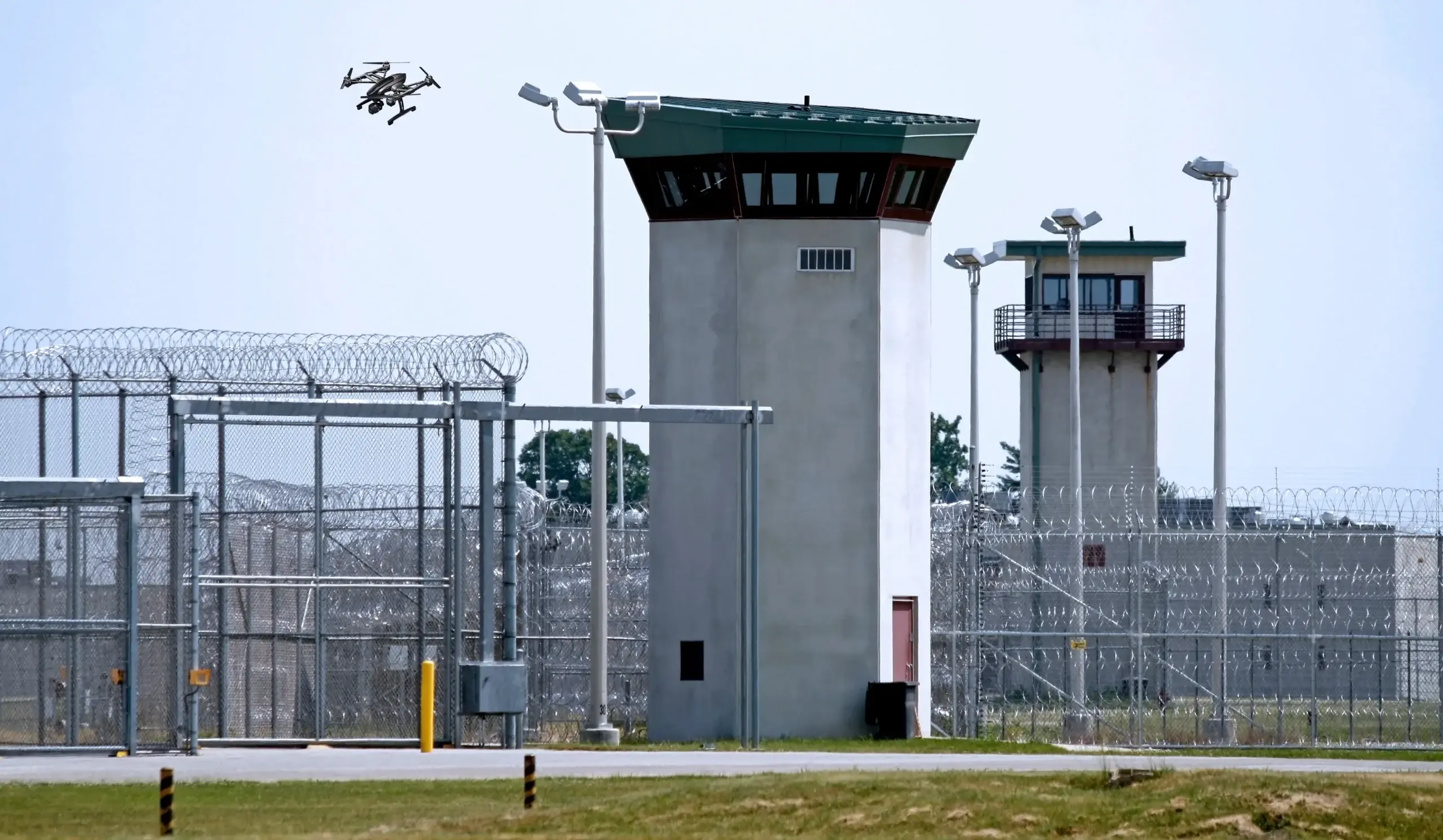Summary: Drone smuggling is rapidly becoming one of the most dangerous and effective ways for criminal organizations to deliver contraband into correctional facilities.
Drone prison threats are rising as drones can carry drugs, weapons, and phones directly to inmates while keeping smugglers anonymous and outside facility walls. Their small size and nighttime flights make them difficult for officers to spot, and a single operator can run multiple missions in an hour.
Because state and local corrections teams cannot intercept drones directly, they rely on timely detection and fast response to prevent contraband drops. High-confidence drone and pilot location alerts are essential to deter these growing threats and protect officer and inmate safety.
Correctional leaders face a constant battle to limit the flow of contraband into prison facilities. Traditionally, contraband has been smuggled into prisons by visitors, “throw-overs”, through the mail, and even by corrections staff. As soon as one delivery method is stopped, criminal organizations immediately find new methods and technologies to meet illicit demand.
Drones and Prison Contraband
As a result, drones are increasingly used to deliver large quantities of contraband into correctional facilities because they provide smugglers with speed, efficiency, and the ability to remain anonymous.
Since state and local corrections departments are not authorized to mitigate or intercept drones, their efforts to stem the tide of contraband rely on consistent identification of, and swift response to, drone incursions.
Contraband introduced into prisons ranges from nuisance items such as snacks, hair cream, and cash to dangerous items such as drugs, phones, escape tools, and weapons that compromise inmate and corrections officer safety.
How are Drones Used to Compromise Prison Security?
Smugglers find it fairly straightforward to use drones to deliver contraband into prisons. Sometimes, drone pilots find contraband delivery jobs on Craigslist.
Smugglers purchase a drone and equip it with a payload release mechanism attachment, readily available online for less than $40. The attachment consists of a simple mechanism that retains the package until the pilot activates the unit’s remote control to release the payload.
The amount of contraband that can be delivered depends on the specific drone’s payload capacity, flight distance, and flight conditions.
Mini drones such as the DJI Mini 2 have a payload of .5 pounds and a stated battery life of 31 minutes. In reality, however, the flight time drops to around 5 minutes when flown at full speed.
Hobby drones, the next size up, have payload capacities ranging from about 0.4 pounds for the DJI Mavic Pro, to around 7.5 pounds for the DJI Inspire 2, and up to 13 pounds for the DJI Matrice 600.
Professional drones move closer to the heavy lift category. For example, the DJI Matrice 600 Pro and OnyxStar HYDRA-12 can exceed payload capacities of 15 pounds.
Once the desired payload has been determined, the operator simply calculates the capacity and flight time to ensure a successful contraband drop.
With extra batteries, the operator can fly multiple missions in an hour.
The operator will position themselves in an inconspicuous location near the correctional facility that will support the number of deliveries desired, ensure the battery won’t die mid-operation, and, of course, provide a fast exit route if discovered.
Where the operator drops the contraband inside the facility will be coordinated with the inmate in charge of the operation. Operators can drop the package in a remote corner of the yard at night, and the intended inmate or corrupt staff will know to go straight there.
Corrections officers conduct sweeps before inmate release, but those patrols have varying efficacy. If the intended recipient does not get to the contraband first, then fights may ensue to control the contraband’s distribution within the facility. With well-trained pilots, drone deliveries can also be coordinated to drop the package directly into an inmate’s hands in broad daylight to ensure accurate delivery.
While the premise of drone-borne contraband is simple, the mechanics of flying a garbage bag full of contraband by drone are actually quite challenging. The added weight often causes erratic drone behavior, especially in windy conditions. It also drains the battery faster than a pilot may expect. As a result, drones and their payloads can crash onto roofs, into fences, or become tangled in tree branches—sometimes never making it out of the woods where they are flown.
A successful drone operator positions the drop over the delivery area, releases the contraband, and flies back for a rapid getaway or additional delivery flights. Operations may include multiple drone pilots for simultaneous or consecutive deliveries or decoy or lookout drones to watch for response unit activity on-site or even at the warden’s residence or local law enforcement offices.
Conclusion - Drones and Prison
It’s simply not enough to rely on training corrections officers to spot incoming drones. The truth is, drones are often confused with birds, planes, or other aircraft and can pretty quickly introduce harmful contraband. Pilots tape the lights at night to fly undetected.
One of the primary objectives of a drone detection system is to prevent contraband deliveries. A system that offers a high-confidence level alert of drone and pilot location, no matter the manufacturer, can prompt appropriate prison actions, such as prison lockdowns. Swift and consistent response serves as a deterrent for criminals attempting contraband deliveries.
Drone Prison Threats FAQs
What kinds of contraband are delivered by drones into prisons?
Drone deliveries into facilities frequently carry cell phones, illicit drugs, cash, weapons, escape tools, and other dangerous items that compromise security.
Why are drones becoming a preferred method for smuggling into prisons?
Drones offer speed, anonymity, the ability to bypass traditional perimeter controls, and low pilot risk. Smugglers can launch near a facility, fly in a payload, and avoid direct detection.
What detection technologies are available to counter drone-based contraband drops at correctional facilities?
Common systems include radio-frequency (RF) systems, radar, electro-optical/infrared cameras, and acoustic sensors to detect drone flight, communications or blade noise. A multi-layered strategy is most effective. (National Institute of Justice)
What are the main operational or legal challenges for prisons deploying drone detection or mitigation systems?
Challenges include: legal constraints on interfering with drones or jamming signals (FAA/EASA rules, FCC regulations), cost and complexity of layered systems, training staff, integrating alerts with response protocols, and the rapidly evolving capabilities of drone operators. (National Institute of Justice)
How should correctional facility leadership approach implementing a drone-detection strategy?
Leaders should conduct a comprehensive threat and risk assessment (drone event frequency, flight paths, payloads), define detection and response protocols, train staff, allocate budget, deploy layered sensors, integrate with existing security systems and maintain legal compliance.
What are the real-world case studies of correctional facilities deploying drone detection systems?
The Georgia Department of Corrections (GDC) deployed the AirWarden system from AeroDefense across multiple state facilities, which helped reduce illegal drone activity. (AeroDefense) These illustrate how detection systems are already being used in the field.
What legal or regulatory issues should corrections facilities consider when using drone detection or mitigation technologies?
- The National Institute of Justice (NIJ) notes that interfering with drones (jamming, takeover) raises FAA/FCC/FAA regulation issues — detection is legally simpler than mitigation. (National Institute of Justice)
- Facilities must consider privacy, data retention, sharing alerts with law enforcement, and pilot-tracking evidence handling (to support prosecution).
- While detection is increasingly practical, full mitigation (jamming or capture) may still face legal/regulatory hurdles.
What are the best-practice steps for a corrections facility looking to implement drone detection for contraband prevention?
- Conduct a threat assessment: map likely drone flight paths, assess previous contraband drop incidents, estimate payloads, frequency, and pilot behavior. (DRONELIFE)
- Define response protocols: what happens when an alert comes in — facility lockdown, staff deployment, law-enforcement coordination, evidence collection.
- Ensure integration: the detection system integrates with the command center, email/text alerts, and historical data/analytics for pattern identification.
- Train staff and maintain operational readiness: staff must be able to interpret alerts, respond appropriately, maintain the system, and act quickly.
- Review legal/regulatory compliance: verify the system is legally deployable in your jurisdiction; ensure data retention and sharing processes are aligned.
- Monitor performance & continuously improve: use analytics and history to identify patterns of drone incursions, adjust alert zones, sensor placement, and response tactics over time. (AeroDefense)


